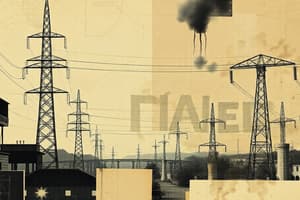Podcast
Questions and Answers
Which component is NOT essential for the flow of current electricity in a circuit?
Which component is NOT essential for the flow of current electricity in a circuit?
- A closed circuit path
- A source of energy that supplies voltage
- A user of electricity
- A safety device to turn off current (correct)
Which type of electricity is characterized by a stationary charge?
Which type of electricity is characterized by a stationary charge?
- Direct Current (DC)
- Electromagnetic Electricity
- Static Electricity (correct)
- Alternating Current (AC)
When does static electricity discharge, often producing a 'spark'?
When does static electricity discharge, often producing a 'spark'?
- When static electricity builds up indefinitely
- When a person touches a conductive object (correct)
- When materials are in contact for too long
- When the charged materials attract each other
What is the primary function of transmission lines in electrical distribution?
What is the primary function of transmission lines in electrical distribution?
Which scenario indicates a violation of workplace electrical safety practices?
Which scenario indicates a violation of workplace electrical safety practices?
What happens to current flow when a circuit path is opened?
What happens to current flow when a circuit path is opened?
In an electric circuit, which element is directly responsible for providing the voltage?
In an electric circuit, which element is directly responsible for providing the voltage?
What is one potential hazard of improperly maintained electrical plugs?
What is one potential hazard of improperly maintained electrical plugs?
What principle explains why electricity flows through a ground wire during a lightning strike?
What principle explains why electricity flows through a ground wire during a lightning strike?
Which of the following describes a key feature of 3-prong electrical plugs?
Which of the following describes a key feature of 3-prong electrical plugs?
Why are birds safe when sitting on live wires?
Why are birds safe when sitting on live wires?
What is a common workplace hazard related to static electricity?
What is a common workplace hazard related to static electricity?
Which method is commonly used for distributing electricity to consumers?
Which method is commonly used for distributing electricity to consumers?
What safety feature do double-insulated 2-prong plugs offer?
What safety feature do double-insulated 2-prong plugs offer?
What would occur if a bird touches both a live wire and a grounded object?
What would occur if a bird touches both a live wire and a grounded object?
Which scenario exemplifies a situation where electricity flows through a circuit?
Which scenario exemplifies a situation where electricity flows through a circuit?
What is a crucial practice to prevent electrical shock when working with electrical equipment?
What is a crucial practice to prevent electrical shock when working with electrical equipment?
Which of the following is an unsafe practice with electrical cords?
Which of the following is an unsafe practice with electrical cords?
What should be done if electrical equipment becomes excessively warm or emits smoke?
What should be done if electrical equipment becomes excessively warm or emits smoke?
When using extension cords, what is an important requirement to maintain safety?
When using extension cords, what is an important requirement to maintain safety?
What is a key guideline to avoid electrical circuit overload?
What is a key guideline to avoid electrical circuit overload?
What is an improper use of electrical cords that can lead to hazards?
What is an improper use of electrical cords that can lead to hazards?
In the context of electrical workplace safety, which of the following practices is discouraged?
In the context of electrical workplace safety, which of the following practices is discouraged?
What preventive measure should be taken regarding electrical equipment to enhance workplace safety?
What preventive measure should be taken regarding electrical equipment to enhance workplace safety?
Flashcards are hidden until you start studying
Study Notes
Types of Electricity
- Static electricity is a stationary electric charge, often created by friction between materials. A common example is the spark from touching a doorknob after walking across a carpet.
- Current electricity requires a closed circuit for flow. This includes an energy source (e.g., battery), a load (e.g., light bulb), a conductor (e.g., wire), and a safety device (e.g., switch, fuse).
- Current electricity exists in two forms: Direct Current (DC) and Alternating Current (AC).
Electrical Workplace Safety
- Never use electrical equipment when any part of your body is near fluids.
- Damaged wires or cables must be replaced immediately.
- Electrical cords should never be placed where they can be tripped over, exposed to heat or liquids, kinked, crushed, or bound. Never pull on the cord to unplug equipment.
- Regularly inspect cords and cables for wear and tear.
- Avoid overloading electrical circuits and the use of octopus adapters.
- Extension cords must match the thickness and rating of the equipment cord.
- Do not use defective equipment, especially if it becomes excessively warm or hot. Unplug equipment immediately if it smokes, even if a mild shock is felt.
How Electricity Works & Distribution
- Electricity follows the path of least resistance. A ground wire provides this path, as seen in lightning rods.
- Flammable materials in the workplace can be ignited by electrical sparks and static electricity.
- Electricity is distributed through a complex system involving power generation, transmission lines, substations, and distribution networks. Transmission lines use high voltage to minimize energy loss over long distances.
Transmission Lines and Electrical Plugs
- Birds don't get electrocuted on power lines because they don't complete a circuit; current doesn't flow through their bodies unless they simultaneously touch a live wire and ground.
- Three-prong plugs (ground plugs) offer protection against electric shock. The ground prong provides a path for stray current to the earth. Two-prong plugs lack this safety feature although some double-insulated appliances may use them.
Studying That Suits You
Use AI to generate personalized quizzes and flashcards to suit your learning preferences.




